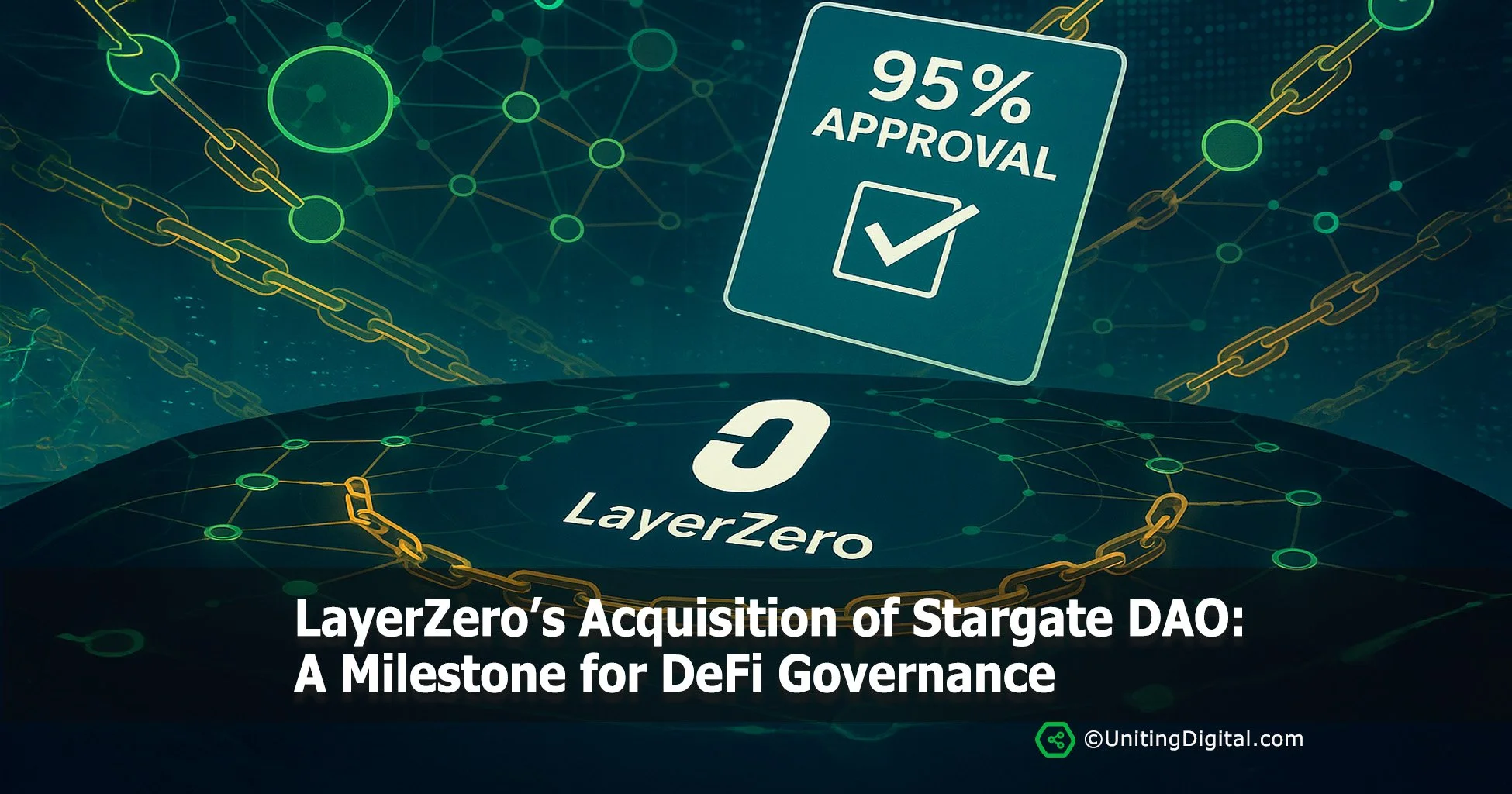LayerZero’s Acquisition of Stargate DAO: A Milestone for DeFi Governance and Cross-Chain Interoperability
LayerZero’s acquisition of Stargate Finance, approved by the Stargate DAO in a landmark vote, represents a pivotal moment for decentralized finance (DeFi) and cross-chain interoperability. Valued at approximately $110 million, this deal dissolves the Stargate DAO and converts all STG tokens to ZRO at a fixed rate of 1 STG to 0.08634 ZRO, based on a price of $0.1675 per STG and $1.94 per ZRO. The acquisition integrates Stargate’s operations under LayerZero’s umbrella following a competitive bidding process that included offers from rivals like Wormhole, which proposed a $120 million cash deal in USDC, as well as interest from Axelar and Across. Despite last-minute challenges, LayerZero modified its terms to include six months of revenue sharing for veSTG holders, securing overwhelming support and highlighting the maturity of DeFi governance.
This transaction not only consolidates two key players in the blockchain space but also underscores the potential for decentralized organizations to handle sophisticated corporate maneuvers. LayerZero, known for its omnichain interoperability protocol that enables seamless messaging across blockchains, originally collaborated on Stargate's development in 2022. By reacquiring Stargate, LayerZero aims to deepen synergies, enhance liquidity provision, and drive innovation in cross-chain applications.
DAO-Led M&A: A New Standard in Decentralized Decision-Making
The approval of LayerZero’s acquisition through Stargate’s tokenholder governance exemplifies decentralized decision-making at its finest. Historically dominated by centralized entities like corporations and venture capitalists, mergers and acquisitions (M&A) are now entering the DAO era. In this case, the strategy and execution were put to a broad community vote, resulting in a transparent and inclusive process.
With an impressive 94.76% to 95% approval rate and high voter turnout, over 15,000 participants casting ballots, the process demonstrated remarkable efficiency. This high engagement level, far surpassing typical corporate shareholder meetings, showcases DeFi governance in action. The successful DAO-led process proves that decentralized organizations can execute complex transactions comparable to traditional M&A, often with greater transparency and community buy-in. It challenges skeptics who view DAOs as experimental or prone to inefficiency, instead positioning them as viable alternatives for strategic capital deployment in the blockchain industry.
Cross-Chain Synergy: Building Unified Infrastructure
Stargate Finance, a leading cross-chain liquidity protocol, facilitates seamless asset transfers across multiple blockchains by leveraging LayerZero’s underlying technology. This acquisition allows LayerZero to regain full control over Stargate, enabling deeper integration and vertical synergies. Potential benefits include improved liquidity pools, unified security protocols, and enhanced composability for DeFi applications, wallets, and platforms.
In the fragmented blockchain landscape of 2025, controlling such middleware is crucial. LayerZero’s $22 billion in Q2 messaging volume positions it to enhance Stargate’s fee capture and expand its offerings, such as stablecoin and OFT hubs. Traditional finance institutions, increasingly monitoring blockchain developments, may interpret this consolidation as a sign of maturing infrastructure standards, bridging the innovative yet chaotic world of DeFi with more regulated reliability. The deal ensures Stargate operations continue without interruption, with LayerZero assuming all duties and focusing on aggressive roadmap execution.
Governance and Industry Impact: Evolving DeFi Standards
Beyond the technical aspects, this deal carries significant political weight. It unfolded over months of proposals, debates, and transparent voting on platforms like Snapshot, instilling new levels of rigor and accountability in DeFi decision-making. At a time when institutional investors are cautiously exploring on-chain models, this acquisition serves as a compelling case study. DAOs, when structured properly, can match or exceed centralized governance standards, debunking notions of inherent recklessness.
The high voter turnout and efficient resolution further emphasize DeFi’s institutional evolution, attracting more capital and credibility. Market reactions post-announcement included a 1% rise in STG price and 0.8% in ZRO, with trading volumes surging over 300%, reflecting trader optimism.
Competitive and Regulatory Outlook: Ripples Across the Ecosystem
This merger is likely to trigger competitive responses. Rivals in bridging and interoperability may accelerate innovations, pursue acquisitions, or advocate for proprietary standards to maintain market share. The last-minute bids underscore the intensifying competition in cross-chain tech.
On the regulatory front, as DAOs scale M&A activities, global authorities will intensify scrutiny of transparency, disclosure, and due diligence. DeFi’s open, pseudonymous nature adds complexity to familiar traditional M&A challenges, potentially leading to new compliance frameworks.
What’s Next: Shaping DeFi’s Future Playbook
Looking ahead, this acquisition could spark a wave of consolidations and partnerships, as protocols seek to build network effects and resilience. Key milestones include the LayerZero-Stargate integration roadmap, post-merger operational management, and reactions from competitors and regulators. The six-month revenue transition and ZRO buyback program will be critical in maintaining community trust.
Ultimately, this deal establishes a template for DeFi expansion, where community-driven allocation, infrastructure ownership, and seamless cross-chain experiences converge to advance the industry. It signals that DAOs are not just participants but architects of blockchain’s future, capable of driving meaningful consolidation and innovation.
About the Author
Arthur Wang

